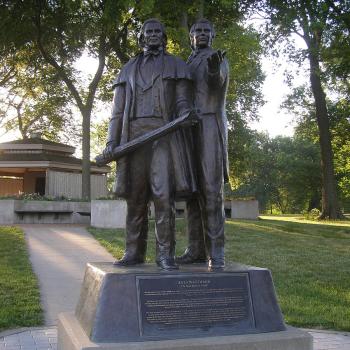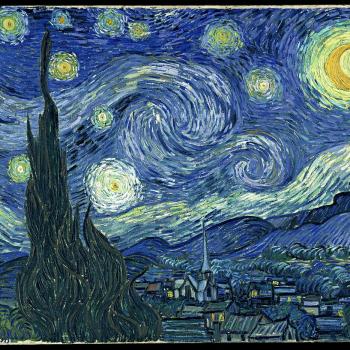
Several years ago, when I was living in Houston, TX, a man walked up to me at a local café and kindly said, "Excuse me sir, you've...um...I think you have dirt on your face."
He was half right.
It wasn’t exactly dirt, but ashes. Ashes smudged on my forehead in the shape – if you looked at it just right and from a 43-degree angle – of a cross.
One could not blame the man for mistaking my visible marker of inward penance and outward allegiance to a particular strand of religiosity…for dirt.
These days, in places like H-town, you don’t see too many people wearing their religion on their face.
Nonetheless, later this month (February 22, 2023) millions of Christians across the world -- Catholic, Lutheran, Anglicans, others – will also don gray smudges on their brows to commemorate Ash Wednesday.
Traditionally viewed as the start of Lent – a 40-day penitential season of fasting and preparation preceding Easter – Ash Wednesday is most widely associated with the "imposition" or "infliction" of ashes on practitioners’ foreheads.
Christians, however, are not alone in marking their faces with religious symbols. There are traditions in India, New Zealand, sub-Saharan Africa and elsewhere that involve religious symbology born on foreheads, cheeks, and chins.
While such outward signs of devotion may seem an extreme in our seemingly secular age, more often than not, these religious facial markings tell us relatively little about the “inner religion” of the devotee and much more about spiritual symbols’ social function(s).
Ash Wednesday
For over twelve hundred years on the dies cinerum (Day of Ashes), faithful followers have approached their respective altars to receive ashes on their foreheads. These ashes are often made from the burnt palm fronds blessed on Palm Sunday the previous year. The ashes are sprinkled with water, usually fragranced with incense and blessed. The ceremonial use of ashes for repentance and penance can be traced even further back.
While traditionally practiced among Roman Catholics, Anglicans, Episcopalians, and Lutherans, there are a growing number of evangelical and other mainline Protestant churches taking up the practice.
Not only are Christians getting their ash in church, but they’re also getting dusted in the streets. In her book City of God, recovering journalist and Episcopalian lay liturgist Sara Miles shared her Lenten adventure perambulating San Francisco's mission district in black cassock on Ash Wednesday marking those she meets with the ashes of Lent. There, in the cracked sidewalks and fractured realities of the city she calls home, Miles found bodies marked not only with poverty and pain, but "the realities of death."
Revealing in an interview with Publisher's Weekly the premise that "God has left the [church] building," Miles said she does not take faith to the streets, but finds it there. "I am in this privileged position to get to see what people's experience of faith and God is, and for each person it is slightly different." In her book she gave voice to this urban canon, this discovery of people who are "hungry for something that's real."
Of marking foreheads with ashes, Miles said the yearning for belief that is solid and can be touched is part of the draw of that ritual. "It's stunning how many people want to be told they are dust and that they will die," she says. "The chronic lie of our culture is that people don't die. But people want to know the truth."
While the ashes may be interpreted as signs of death and repentance, they also serve a social function. In recent years, numerous practitioners have taken to social media with hashtags like #Ashtag or #showmeyourash, posting photos of their ashen foreheads on Twitter and Instagram, Facebook or Snapchat.
This hints at the dual function that ashes play for those who wear them – they are a means of expressing belief in the public square. They are a way, in other words, to tell others – at least one day of the year – “I am Christian” or, to go with Miles, “I will die.”
This public performance can produce a tension within, with some rushing hurriedly to wash away the ashes before going back to work or seeing others at a social function. For others, however, the ashes are a way to assert their Christian identification, provide legitimization to their beliefs, and affirm their core values in public fashion.
South Indian Tripundra
Something similar might be said for the mark of a saiva in South India known as the "tripundra" (or "tilak").
Consisting of three horizontal lines of vibhuti (holy ash) on the forehead often with a dot (bindu) acting as "a third eye," the tripundra evokes something of Ash Wednesday practice.
However, there are different motivations in this Hindu tradition. The three lines symbolize the self's (atman's) three bonds: anava (the sense of “I” within each of us), karma (the effect, or fruits, of a person's actions in this life and the next), and maya (power and wisdom).
According to Dr. Elaine Fisher of Stanford University, the vibhuti, composed of burnt cow dung, or in some Shaiva traditions the funerary ashes of cremated corpses, is an omnipresent reminder of the temporary nature of physical existence and the urgency to strive for self-realization and spiritual attainment (moksha).
As Fischer explained, the bearing of tripundra actively marks one in South India as part of a certain religious public and community, but it tells us little else about other aspects of their religious identity.
Māori Ta Moko
This dynamic is even more evident in the modern practice of ta moko among Māori, and others, in Aotearoa (New Zealand).
According to Māori tradition, each individual’s ta moko is unique and sacred. The traditional way of applying ta moko to the face was to dip a narrow blade in black pigment and then tap the blade with a mallet to chisel deep incisions into the skin. This process not only left a tattoo of the designs, but permanent grooves in the skin. Today, most ta moko are tattooed according to international standards, but still informed by Māori tradition and symbols.
The traditional form of ta moko was practiced by tohunga, who were both ritual experts and skilled artisans. A woman’s moko, which covered only the chin and lips, would take one or two days to complete. A man’s moko, which covered the whole face, was done in stages over several years due to the immense pain, swelling, and blood often involved in the process. Because of this, while the scars were healing, the person being tattooed was in a state of tapu (taboo, sacred or set apart). They could not look in a mirror, touch their own food, engage in sexual activity, or even wash the tattooed skin.
Since the 1970s and 80s, some Māori have begun wearing ta moko again as a marker, and assertion of their cultural identity as part of a wider Māori cultural revival (Ngā tuakiri hōu). Even a few Māori tattoo artists are reviving traditional methods of applying ta moko to the face, thighs, and arms. Formerly a sign of status and prestige, now Māori people who wear ta moko assert their identification in a world of rapid change and cultural incursion. This recently came to the fore of public consciousness in New Zealand when Māori journalist Oriini Kaipara has made history as the first person to anchor a primetime news slot with a traditional face tattoo.
Making Myself Tapu
Regardless of source or tradition, most who do not bear such religious facial markings may react with surprise – or even horror – when they see someone with their religious identity splashed, or scarred, across their faces. Extreme. Outlandish. Drastic.
In one sense, inscribing, or marking, one's religion on one's face is powerful and evocative. Not only does it identify the believer with a particular religious or cultural community, but it demarcates them as different, other, or tapu.
By marking one's body, either permanently or temporarily, the adherent weaves themselves into the dogmatic and ritualistic narrative of their religion. With permanent markings, this placement is deeper both physically – scars and chiseled skin – and spiritually.
Yet, as has been hinted at throughout this post, while these markings may disclose a particular religious self-identification or membership in a certain religious community or body politic, they tell us very little about how these individuals construct their daily religious life or if they do so at all.
In a globalized world, notions of cultural and religious belonging become a precious commodity. Thus, facial markings are a way to fetishize the body, to inscribe it with communal meaning, profound purpose, and public sacrality in a world perceived as increasingly homogenous, superficial, individualized, and secular.
When it comes to things like ashes for Ash Wednesday, such markings are temporary. Nonetheless, they force the issue of religiosity in a world increasingly perceived – and constructed – as secular and drive us to ask why it is that so many, whether Christian, Māori, or Hindu, choose not only to bear their religion on their face, but put it in ours as they meet us in the public square.
By proudly bearing their markings for a day, a season, or their entire lives, these devotees and religious faithful are a constant reminder that religion has not gone by the wayside in a globalized world, but is ever more present, potent, and potentially "in our face."
2/4/2023 12:23:02 AM





